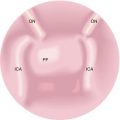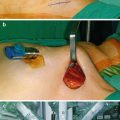Recurrent thyrotoxicosis
Recurrent compressive symptoms for a MNG
Completion surgery for cancer
Locoregional cancer recurrence
Review or change in pathological diagnosis
New pathology (hyperparathyroidism)
Minimizing Rate of Revision Thyroid Surgery
Revision surgery can be reduced by correctly managing pathological and surgical factors at the time of their primary surgery (Table 23.2).
Table 23.2
Pathological and surgical factors influencing revision surgery
Avoidable pathological factors
Avoidable surgical factors
Error in cytological diagnosis
Inappropriate primary procedure
Error in pathological diagnosis
Inadequate primary procedure, a correct preoperative diagnosis should direct the correct primary surgical strategy
Unavoidable pathological factors
Unavoidable surgical factors
Completion of thyroid surgery based on pathology
New or recurrent pathology
Failure to make a preoperative diagnosis
Complications
Complications of revision surgery are higher particularly in inexperienced, low-volume surgeons.
Recurrent laryngeal nerve injury is more likely if revision surgery is undertaken on the same side as previous surgery (14 %) compared to the contralateral side (3.2 %) (Table 23.3) (Scott-Coombes et al. 2009).
Table 23.3
Complications of revision surgery (Alesina et al. 2008; Scott-Coombes et al. 2009; Bergenfelz et al. 2008; Cappellani et al. 2008; Kronz and Westra 2005; Kupferman et al. 2002; Lefevre et al. 2007; Menegaux et al. 1999; Mishra and Mishra 2002; Randolph et al. 2011; Robert 2005; Watkinson 2010; Wu et al. 2011)
Primary surgery
Revision surgery
Recurrent laryngeal nerve injury
Temporary
1.8–4.8 %
1–4.1 %
Permanent
0.4–4.0 %
1.2–5.4 %
Hypocalcemia
Temporary
9.9–32.3 %
5–14.8 %
Permanent
1.0–17.3 %
2.5–15.5 %
Bleeding
0.9–2.1 %
0.7–3.5 %
Infection
1.6 %
0.2 %
Preoperative Work-Up
Surgery should preferably be undertaken by high-volume surgeons.
Review pathological and cytological diagnosis in a thyroid MDT meeting.
Preferably review previous operation record. Specifically seek information about the procedure performed, identification of the RLN, and parathyroid glands.
Preoperative vocal cord assessment is mandatory.
Repeat cross-sectional imaging may be indicated to facilitate surgical planning.
The aim in the majority of patients is to undertake a total or completion thyroidectomy.
Operative Technique
Nerve monitoring can aid both identification and dissection of the RLN in scar tissue.
The previous incision should be used.
The procedure may be executed by a conventional midline or lateral approach.
Expose the strap muscles in the midline and laterally to the sternomastoid muscle.
Conventional midline approach | Lateral approach |
|---|---|
Strap muscles are separated in midline. The trachea is a useful guide because the midline raphe may have already been disrupted during original surgery
Stay updated, free articles. Join our Telegram channel
Full access? Get Clinical Tree
 Get Clinical Tree app for offline access
Get Clinical Tree app for offline access

|


